Global Business and Strategy Report: Sainsbury's Case Study
VerifiedAdded on 2023/01/17
|10
|3174
|43
Report
AI Summary
This report offers a comprehensive analysis of Sainsbury's global business strategy, particularly its venture into the Chinese market. It begins with an overview of the case study, highlighting Sainsbury's expansion efforts and financial performance. The report then delves into internal and external factors influencing Sainsbury's operations, employing SWOT and PESTLE analyses to assess strengths, weaknesses, opportunities, and threats, as well as political, economic, social, technological, legal, and environmental factors. Furthermore, it identifies Sainsbury's sustainable competitive advantages using Porter's Five Forces analysis, evaluating competitive rivalry, supplier power, threat of substitutes, buyer power, and the threat of new entrants. Finally, the report provides strategic recommendations based on the analyses and concludes with a summary of key findings and implications for Sainsbury's future global business endeavors.
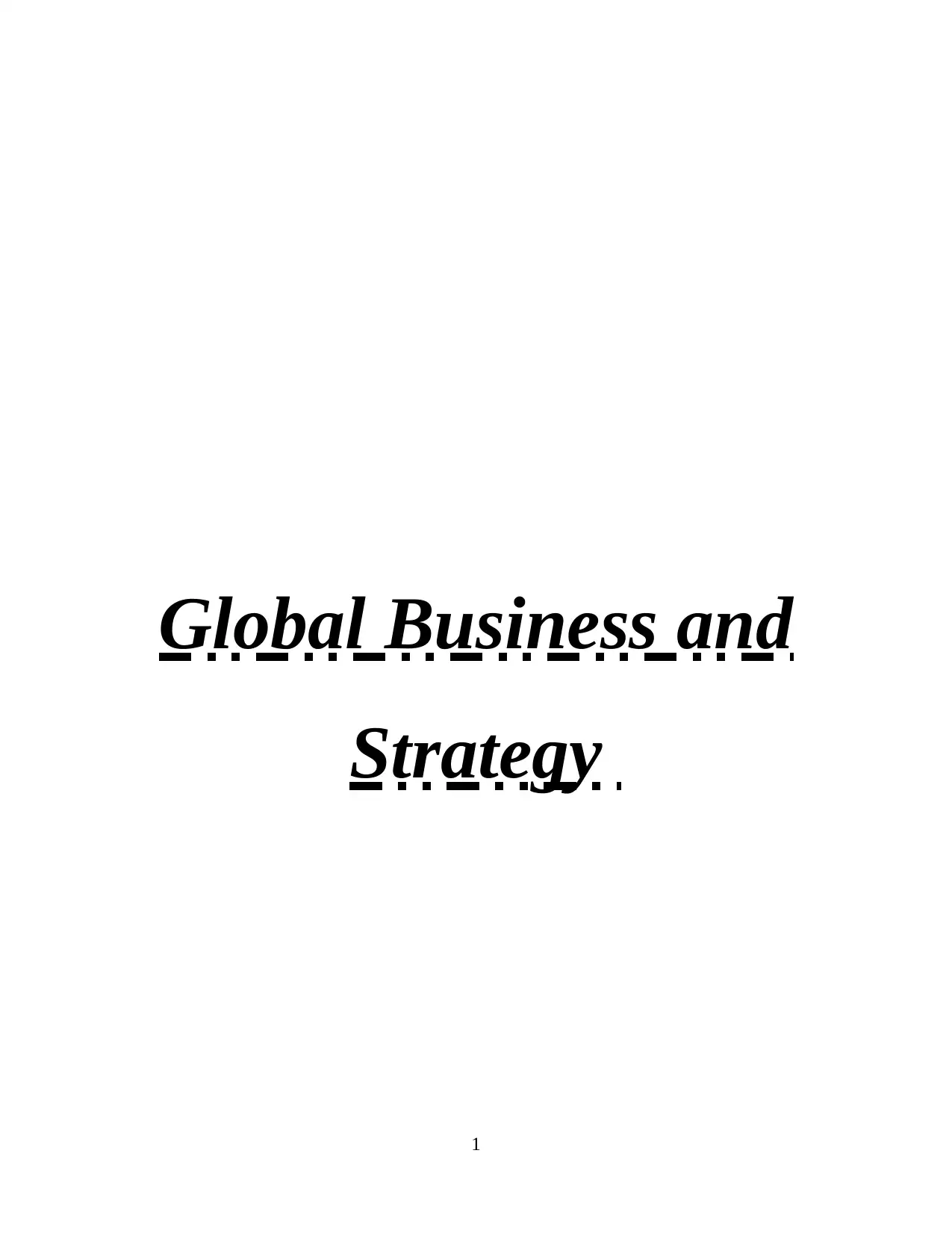
Global Business and
Strategy
1
Strategy
1
Paraphrase This Document
Need a fresh take? Get an instant paraphrase of this document with our AI Paraphraser
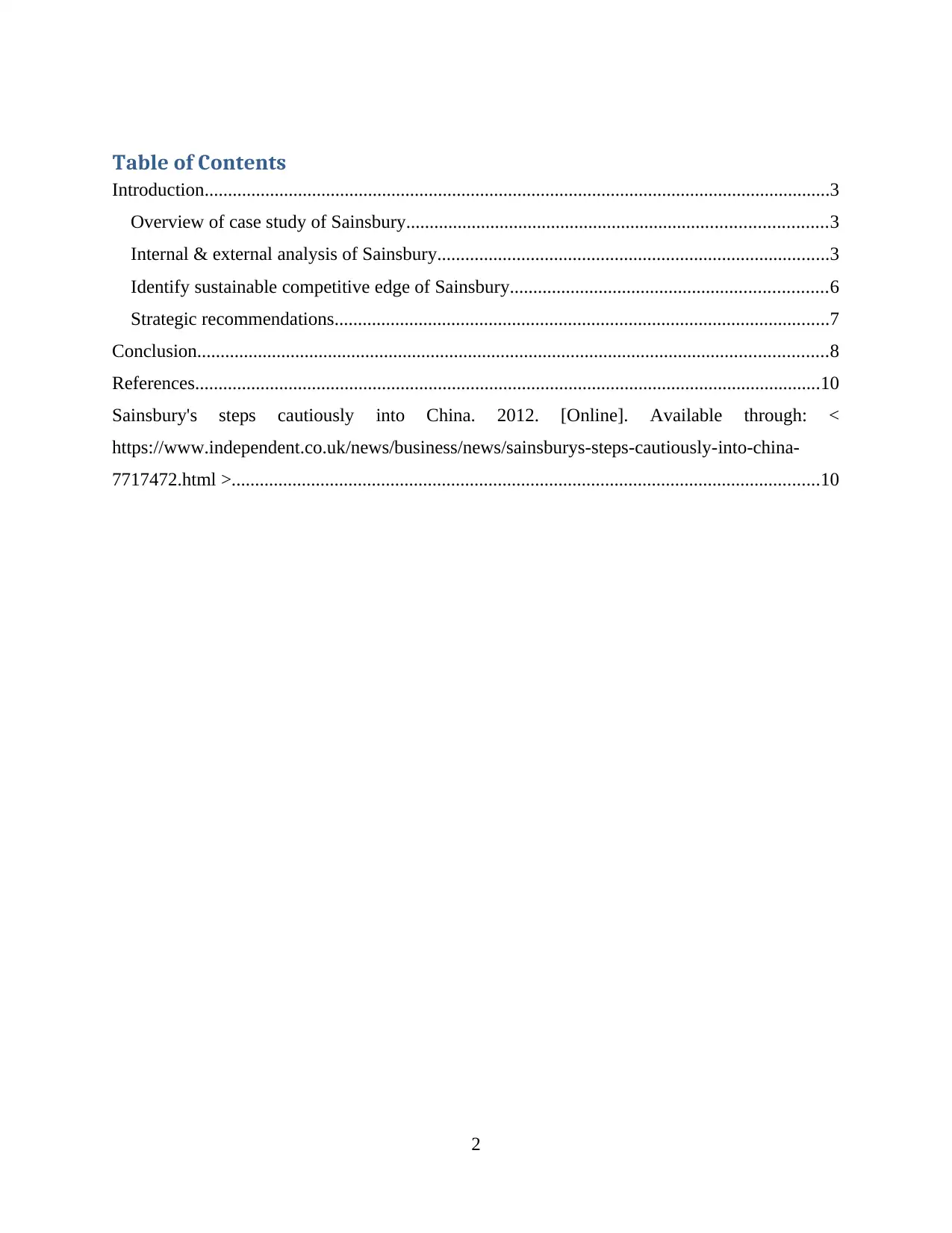
Table of Contents
Introduction......................................................................................................................................3
Overview of case study of Sainsbury..........................................................................................3
Internal & external analysis of Sainsbury....................................................................................3
Identify sustainable competitive edge of Sainsbury....................................................................6
Strategic recommendations..........................................................................................................7
Conclusion.......................................................................................................................................8
References......................................................................................................................................10
Sainsbury's steps cautiously into China. 2012. [Online]. Available through: <
https://www.independent.co.uk/news/business/news/sainsburys-steps-cautiously-into-china-
7717472.html >..............................................................................................................................10
2
Introduction......................................................................................................................................3
Overview of case study of Sainsbury..........................................................................................3
Internal & external analysis of Sainsbury....................................................................................3
Identify sustainable competitive edge of Sainsbury....................................................................6
Strategic recommendations..........................................................................................................7
Conclusion.......................................................................................................................................8
References......................................................................................................................................10
Sainsbury's steps cautiously into China. 2012. [Online]. Available through: <
https://www.independent.co.uk/news/business/news/sainsburys-steps-cautiously-into-china-
7717472.html >..............................................................................................................................10
2
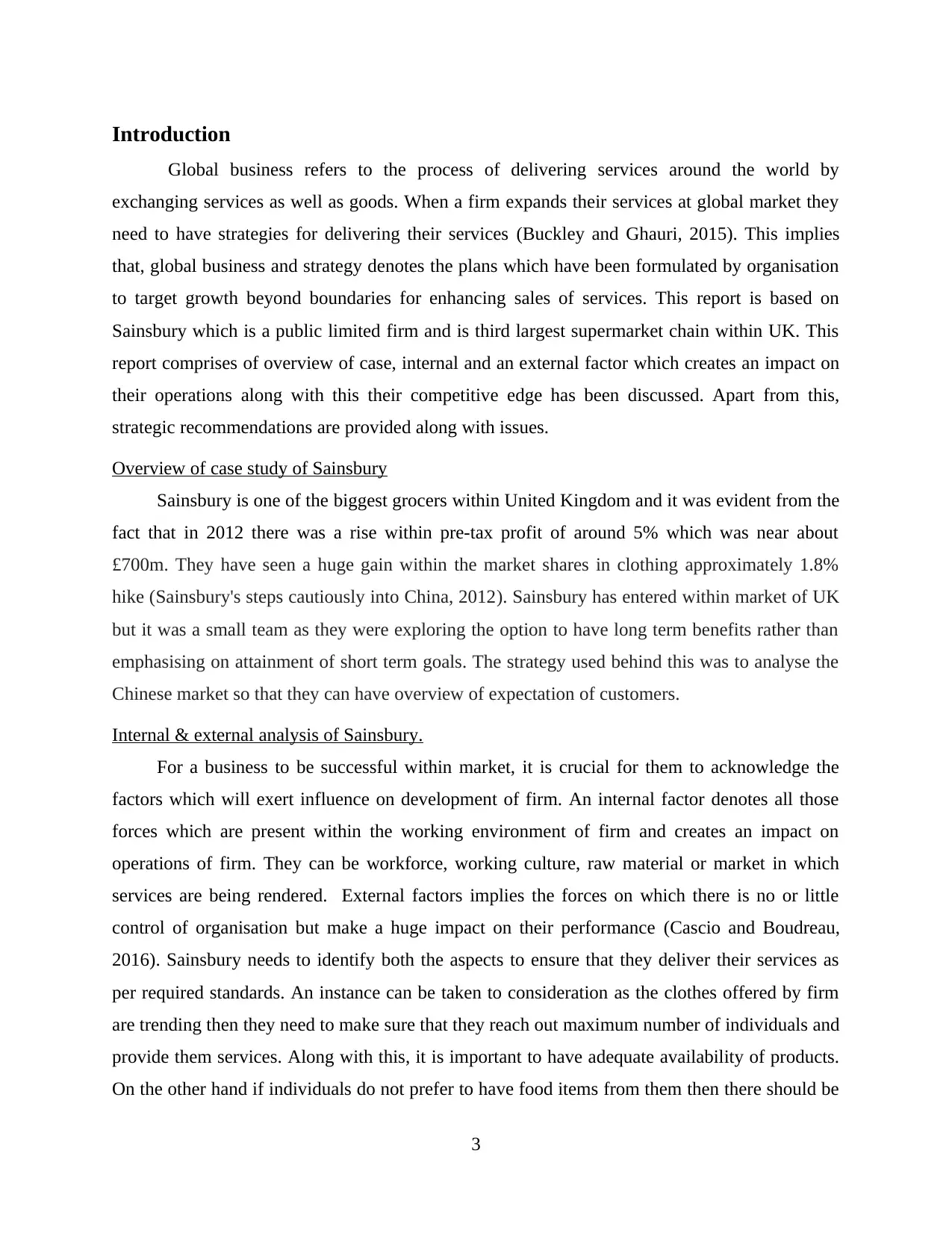
Introduction
Global business refers to the process of delivering services around the world by
exchanging services as well as goods. When a firm expands their services at global market they
need to have strategies for delivering their services (Buckley and Ghauri, 2015). This implies
that, global business and strategy denotes the plans which have been formulated by organisation
to target growth beyond boundaries for enhancing sales of services. This report is based on
Sainsbury which is a public limited firm and is third largest supermarket chain within UK. This
report comprises of overview of case, internal and an external factor which creates an impact on
their operations along with this their competitive edge has been discussed. Apart from this,
strategic recommendations are provided along with issues.
Overview of case study of Sainsbury
Sainsbury is one of the biggest grocers within United Kingdom and it was evident from the
fact that in 2012 there was a rise within pre-tax profit of around 5% which was near about
£700m. They have seen a huge gain within the market shares in clothing approximately 1.8%
hike (Sainsbury's steps cautiously into China, 2012). Sainsbury has entered within market of UK
but it was a small team as they were exploring the option to have long term benefits rather than
emphasising on attainment of short term goals. The strategy used behind this was to analyse the
Chinese market so that they can have overview of expectation of customers.
Internal & external analysis of Sainsbury.
For a business to be successful within market, it is crucial for them to acknowledge the
factors which will exert influence on development of firm. An internal factor denotes all those
forces which are present within the working environment of firm and creates an impact on
operations of firm. They can be workforce, working culture, raw material or market in which
services are being rendered. External factors implies the forces on which there is no or little
control of organisation but make a huge impact on their performance (Cascio and Boudreau,
2016). Sainsbury needs to identify both the aspects to ensure that they deliver their services as
per required standards. An instance can be taken to consideration as the clothes offered by firm
are trending then they need to make sure that they reach out maximum number of individuals and
provide them services. Along with this, it is important to have adequate availability of products.
On the other hand if individuals do not prefer to have food items from them then there should be
3
Global business refers to the process of delivering services around the world by
exchanging services as well as goods. When a firm expands their services at global market they
need to have strategies for delivering their services (Buckley and Ghauri, 2015). This implies
that, global business and strategy denotes the plans which have been formulated by organisation
to target growth beyond boundaries for enhancing sales of services. This report is based on
Sainsbury which is a public limited firm and is third largest supermarket chain within UK. This
report comprises of overview of case, internal and an external factor which creates an impact on
their operations along with this their competitive edge has been discussed. Apart from this,
strategic recommendations are provided along with issues.
Overview of case study of Sainsbury
Sainsbury is one of the biggest grocers within United Kingdom and it was evident from the
fact that in 2012 there was a rise within pre-tax profit of around 5% which was near about
£700m. They have seen a huge gain within the market shares in clothing approximately 1.8%
hike (Sainsbury's steps cautiously into China, 2012). Sainsbury has entered within market of UK
but it was a small team as they were exploring the option to have long term benefits rather than
emphasising on attainment of short term goals. The strategy used behind this was to analyse the
Chinese market so that they can have overview of expectation of customers.
Internal & external analysis of Sainsbury.
For a business to be successful within market, it is crucial for them to acknowledge the
factors which will exert influence on development of firm. An internal factor denotes all those
forces which are present within the working environment of firm and creates an impact on
operations of firm. They can be workforce, working culture, raw material or market in which
services are being rendered. External factors implies the forces on which there is no or little
control of organisation but make a huge impact on their performance (Cascio and Boudreau,
2016). Sainsbury needs to identify both the aspects to ensure that they deliver their services as
per required standards. An instance can be taken to consideration as the clothes offered by firm
are trending then they need to make sure that they reach out maximum number of individuals and
provide them services. Along with this, it is important to have adequate availability of products.
On the other hand if individuals do not prefer to have food items from them then there should be
3
⊘ This is a preview!⊘
Do you want full access?
Subscribe today to unlock all pages.

Trusted by 1+ million students worldwide
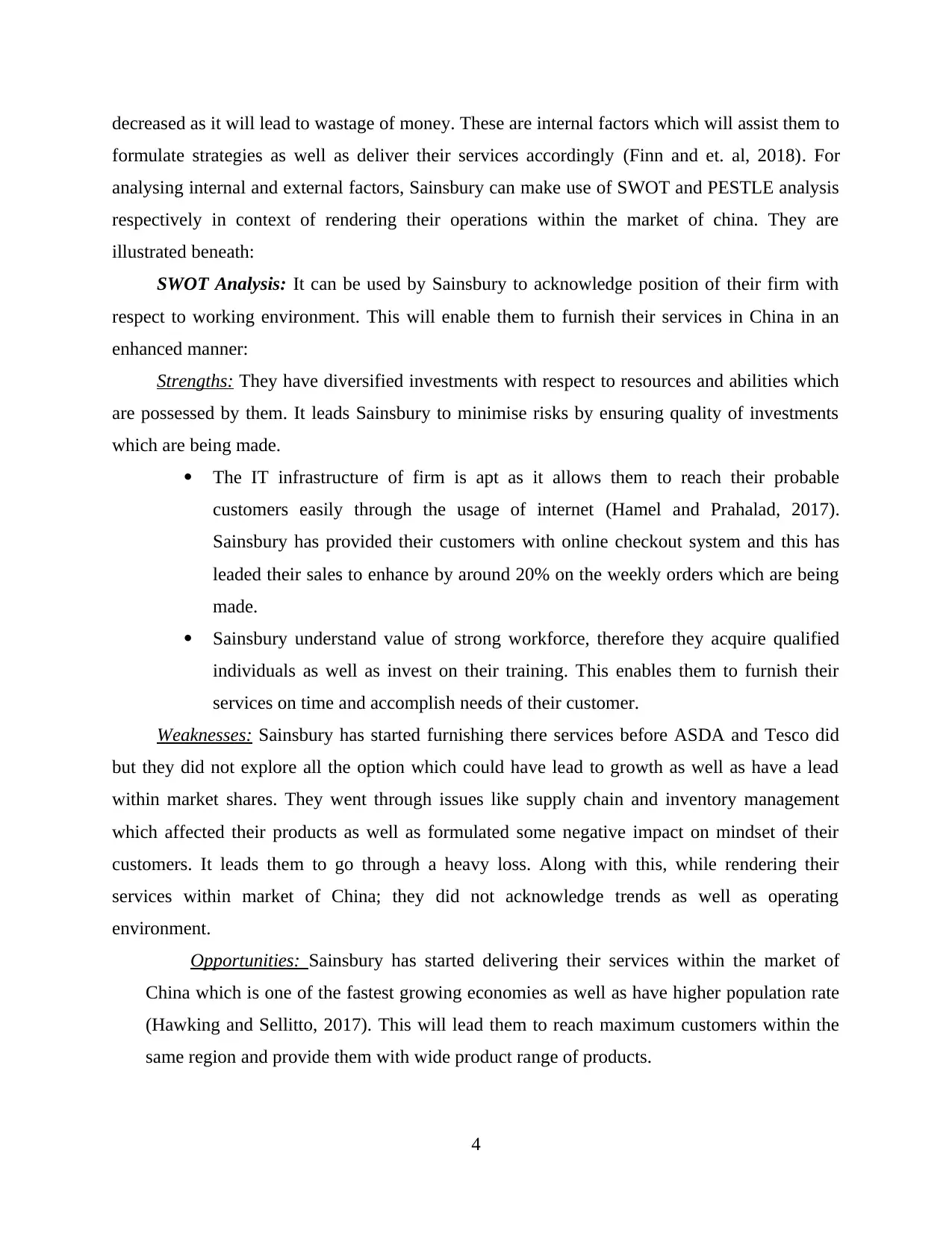
decreased as it will lead to wastage of money. These are internal factors which will assist them to
formulate strategies as well as deliver their services accordingly (Finn and et. al, 2018). For
analysing internal and external factors, Sainsbury can make use of SWOT and PESTLE analysis
respectively in context of rendering their operations within the market of china. They are
illustrated beneath:
SWOT Analysis: It can be used by Sainsbury to acknowledge position of their firm with
respect to working environment. This will enable them to furnish their services in China in an
enhanced manner:
Strengths: They have diversified investments with respect to resources and abilities which
are possessed by them. It leads Sainsbury to minimise risks by ensuring quality of investments
which are being made.
The IT infrastructure of firm is apt as it allows them to reach their probable
customers easily through the usage of internet (Hamel and Prahalad, 2017).
Sainsbury has provided their customers with online checkout system and this has
leaded their sales to enhance by around 20% on the weekly orders which are being
made.
Sainsbury understand value of strong workforce, therefore they acquire qualified
individuals as well as invest on their training. This enables them to furnish their
services on time and accomplish needs of their customer.
Weaknesses: Sainsbury has started furnishing there services before ASDA and Tesco did
but they did not explore all the option which could have lead to growth as well as have a lead
within market shares. They went through issues like supply chain and inventory management
which affected their products as well as formulated some negative impact on mindset of their
customers. It leads them to go through a heavy loss. Along with this, while rendering their
services within market of China; they did not acknowledge trends as well as operating
environment.
Opportunities: Sainsbury has started delivering their services within the market of
China which is one of the fastest growing economies as well as have higher population rate
(Hawking and Sellitto, 2017). This will lead them to reach maximum customers within the
same region and provide them with wide product range of products.
4
formulate strategies as well as deliver their services accordingly (Finn and et. al, 2018). For
analysing internal and external factors, Sainsbury can make use of SWOT and PESTLE analysis
respectively in context of rendering their operations within the market of china. They are
illustrated beneath:
SWOT Analysis: It can be used by Sainsbury to acknowledge position of their firm with
respect to working environment. This will enable them to furnish their services in China in an
enhanced manner:
Strengths: They have diversified investments with respect to resources and abilities which
are possessed by them. It leads Sainsbury to minimise risks by ensuring quality of investments
which are being made.
The IT infrastructure of firm is apt as it allows them to reach their probable
customers easily through the usage of internet (Hamel and Prahalad, 2017).
Sainsbury has provided their customers with online checkout system and this has
leaded their sales to enhance by around 20% on the weekly orders which are being
made.
Sainsbury understand value of strong workforce, therefore they acquire qualified
individuals as well as invest on their training. This enables them to furnish their
services on time and accomplish needs of their customer.
Weaknesses: Sainsbury has started furnishing there services before ASDA and Tesco did
but they did not explore all the option which could have lead to growth as well as have a lead
within market shares. They went through issues like supply chain and inventory management
which affected their products as well as formulated some negative impact on mindset of their
customers. It leads them to go through a heavy loss. Along with this, while rendering their
services within market of China; they did not acknowledge trends as well as operating
environment.
Opportunities: Sainsbury has started delivering their services within the market of
China which is one of the fastest growing economies as well as have higher population rate
(Hawking and Sellitto, 2017). This will lead them to reach maximum customers within the
same region and provide them with wide product range of products.
4
Paraphrase This Document
Need a fresh take? Get an instant paraphrase of this document with our AI Paraphraser
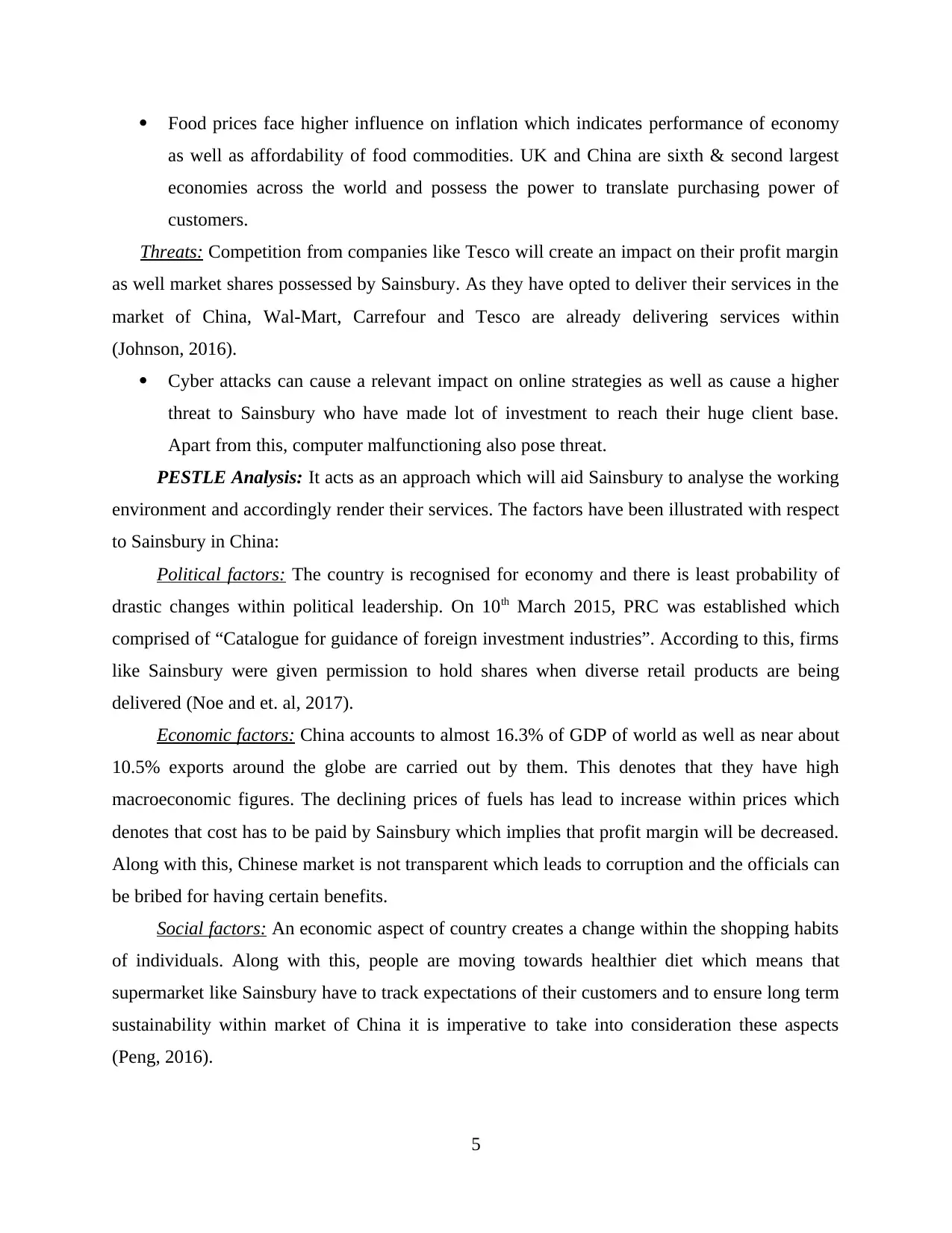
Food prices face higher influence on inflation which indicates performance of economy
as well as affordability of food commodities. UK and China are sixth & second largest
economies across the world and possess the power to translate purchasing power of
customers.
Threats: Competition from companies like Tesco will create an impact on their profit margin
as well market shares possessed by Sainsbury. As they have opted to deliver their services in the
market of China, Wal-Mart, Carrefour and Tesco are already delivering services within
(Johnson, 2016).
Cyber attacks can cause a relevant impact on online strategies as well as cause a higher
threat to Sainsbury who have made lot of investment to reach their huge client base.
Apart from this, computer malfunctioning also pose threat.
PESTLE Analysis: It acts as an approach which will aid Sainsbury to analyse the working
environment and accordingly render their services. The factors have been illustrated with respect
to Sainsbury in China:
Political factors: The country is recognised for economy and there is least probability of
drastic changes within political leadership. On 10th March 2015, PRC was established which
comprised of “Catalogue for guidance of foreign investment industries”. According to this, firms
like Sainsbury were given permission to hold shares when diverse retail products are being
delivered (Noe and et. al, 2017).
Economic factors: China accounts to almost 16.3% of GDP of world as well as near about
10.5% exports around the globe are carried out by them. This denotes that they have high
macroeconomic figures. The declining prices of fuels has lead to increase within prices which
denotes that cost has to be paid by Sainsbury which implies that profit margin will be decreased.
Along with this, Chinese market is not transparent which leads to corruption and the officials can
be bribed for having certain benefits.
Social factors: An economic aspect of country creates a change within the shopping habits
of individuals. Along with this, people are moving towards healthier diet which means that
supermarket like Sainsbury have to track expectations of their customers and to ensure long term
sustainability within market of China it is imperative to take into consideration these aspects
(Peng, 2016).
5
as well as affordability of food commodities. UK and China are sixth & second largest
economies across the world and possess the power to translate purchasing power of
customers.
Threats: Competition from companies like Tesco will create an impact on their profit margin
as well market shares possessed by Sainsbury. As they have opted to deliver their services in the
market of China, Wal-Mart, Carrefour and Tesco are already delivering services within
(Johnson, 2016).
Cyber attacks can cause a relevant impact on online strategies as well as cause a higher
threat to Sainsbury who have made lot of investment to reach their huge client base.
Apart from this, computer malfunctioning also pose threat.
PESTLE Analysis: It acts as an approach which will aid Sainsbury to analyse the working
environment and accordingly render their services. The factors have been illustrated with respect
to Sainsbury in China:
Political factors: The country is recognised for economy and there is least probability of
drastic changes within political leadership. On 10th March 2015, PRC was established which
comprised of “Catalogue for guidance of foreign investment industries”. According to this, firms
like Sainsbury were given permission to hold shares when diverse retail products are being
delivered (Noe and et. al, 2017).
Economic factors: China accounts to almost 16.3% of GDP of world as well as near about
10.5% exports around the globe are carried out by them. This denotes that they have high
macroeconomic figures. The declining prices of fuels has lead to increase within prices which
denotes that cost has to be paid by Sainsbury which implies that profit margin will be decreased.
Along with this, Chinese market is not transparent which leads to corruption and the officials can
be bribed for having certain benefits.
Social factors: An economic aspect of country creates a change within the shopping habits
of individuals. Along with this, people are moving towards healthier diet which means that
supermarket like Sainsbury have to track expectations of their customers and to ensure long term
sustainability within market of China it is imperative to take into consideration these aspects
(Peng, 2016).
5
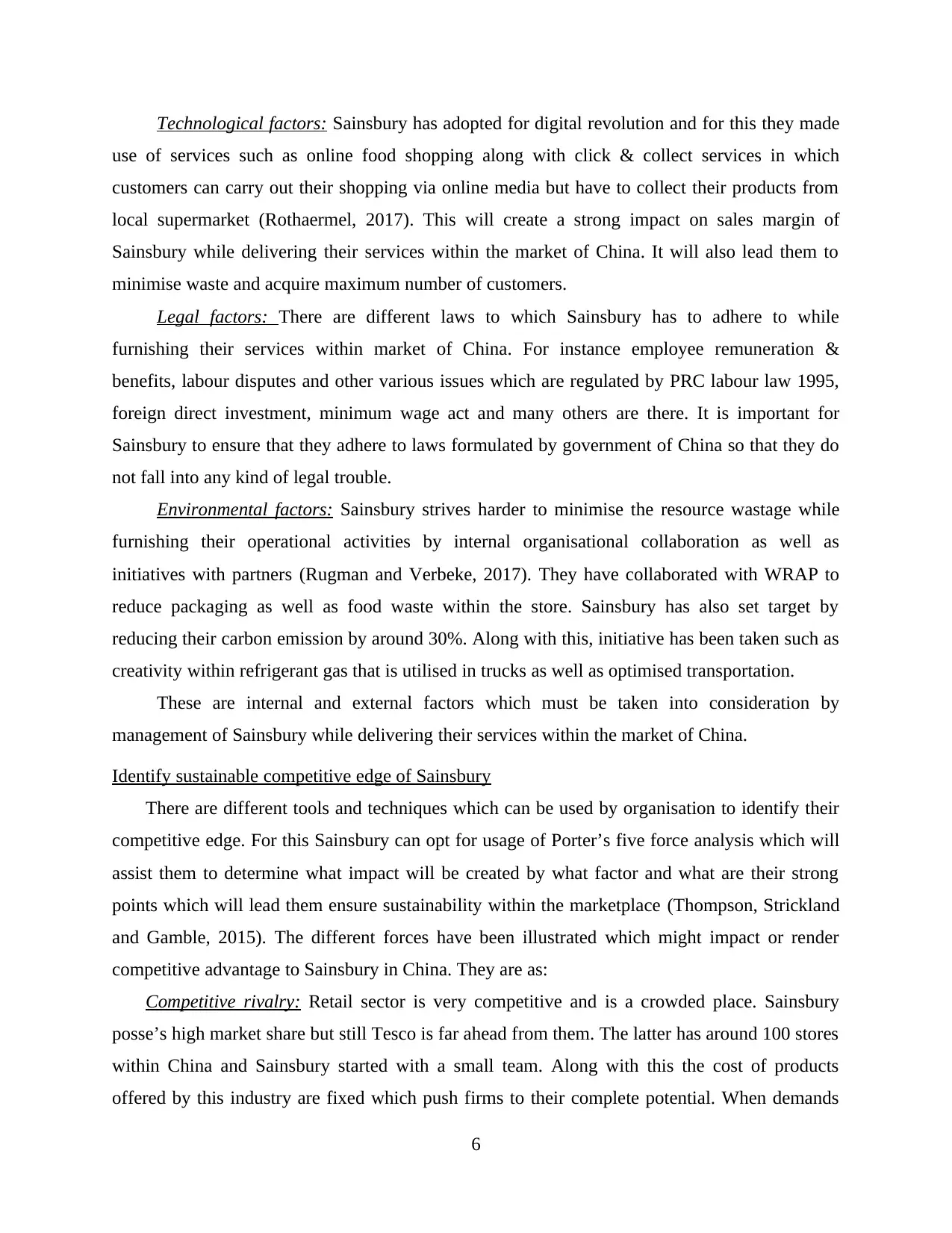
Technological factors: Sainsbury has adopted for digital revolution and for this they made
use of services such as online food shopping along with click & collect services in which
customers can carry out their shopping via online media but have to collect their products from
local supermarket (Rothaermel, 2017). This will create a strong impact on sales margin of
Sainsbury while delivering their services within the market of China. It will also lead them to
minimise waste and acquire maximum number of customers.
Legal factors: There are different laws to which Sainsbury has to adhere to while
furnishing their services within market of China. For instance employee remuneration &
benefits, labour disputes and other various issues which are regulated by PRC labour law 1995,
foreign direct investment, minimum wage act and many others are there. It is important for
Sainsbury to ensure that they adhere to laws formulated by government of China so that they do
not fall into any kind of legal trouble.
Environmental factors: Sainsbury strives harder to minimise the resource wastage while
furnishing their operational activities by internal organisational collaboration as well as
initiatives with partners (Rugman and Verbeke, 2017). They have collaborated with WRAP to
reduce packaging as well as food waste within the store. Sainsbury has also set target by
reducing their carbon emission by around 30%. Along with this, initiative has been taken such as
creativity within refrigerant gas that is utilised in trucks as well as optimised transportation.
These are internal and external factors which must be taken into consideration by
management of Sainsbury while delivering their services within the market of China.
Identify sustainable competitive edge of Sainsbury
There are different tools and techniques which can be used by organisation to identify their
competitive edge. For this Sainsbury can opt for usage of Porter’s five force analysis which will
assist them to determine what impact will be created by what factor and what are their strong
points which will lead them ensure sustainability within the marketplace (Thompson, Strickland
and Gamble, 2015). The different forces have been illustrated which might impact or render
competitive advantage to Sainsbury in China. They are as:
Competitive rivalry: Retail sector is very competitive and is a crowded place. Sainsbury
posse’s high market share but still Tesco is far ahead from them. The latter has around 100 stores
within China and Sainsbury started with a small team. Along with this the cost of products
offered by this industry are fixed which push firms to their complete potential. When demands
6
use of services such as online food shopping along with click & collect services in which
customers can carry out their shopping via online media but have to collect their products from
local supermarket (Rothaermel, 2017). This will create a strong impact on sales margin of
Sainsbury while delivering their services within the market of China. It will also lead them to
minimise waste and acquire maximum number of customers.
Legal factors: There are different laws to which Sainsbury has to adhere to while
furnishing their services within market of China. For instance employee remuneration &
benefits, labour disputes and other various issues which are regulated by PRC labour law 1995,
foreign direct investment, minimum wage act and many others are there. It is important for
Sainsbury to ensure that they adhere to laws formulated by government of China so that they do
not fall into any kind of legal trouble.
Environmental factors: Sainsbury strives harder to minimise the resource wastage while
furnishing their operational activities by internal organisational collaboration as well as
initiatives with partners (Rugman and Verbeke, 2017). They have collaborated with WRAP to
reduce packaging as well as food waste within the store. Sainsbury has also set target by
reducing their carbon emission by around 30%. Along with this, initiative has been taken such as
creativity within refrigerant gas that is utilised in trucks as well as optimised transportation.
These are internal and external factors which must be taken into consideration by
management of Sainsbury while delivering their services within the market of China.
Identify sustainable competitive edge of Sainsbury
There are different tools and techniques which can be used by organisation to identify their
competitive edge. For this Sainsbury can opt for usage of Porter’s five force analysis which will
assist them to determine what impact will be created by what factor and what are their strong
points which will lead them ensure sustainability within the marketplace (Thompson, Strickland
and Gamble, 2015). The different forces have been illustrated which might impact or render
competitive advantage to Sainsbury in China. They are as:
Competitive rivalry: Retail sector is very competitive and is a crowded place. Sainsbury
posse’s high market share but still Tesco is far ahead from them. The latter has around 100 stores
within China and Sainsbury started with a small team. Along with this the cost of products
offered by this industry are fixed which push firms to their complete potential. When demands
6
⊘ This is a preview!⊘
Do you want full access?
Subscribe today to unlock all pages.

Trusted by 1+ million students worldwide
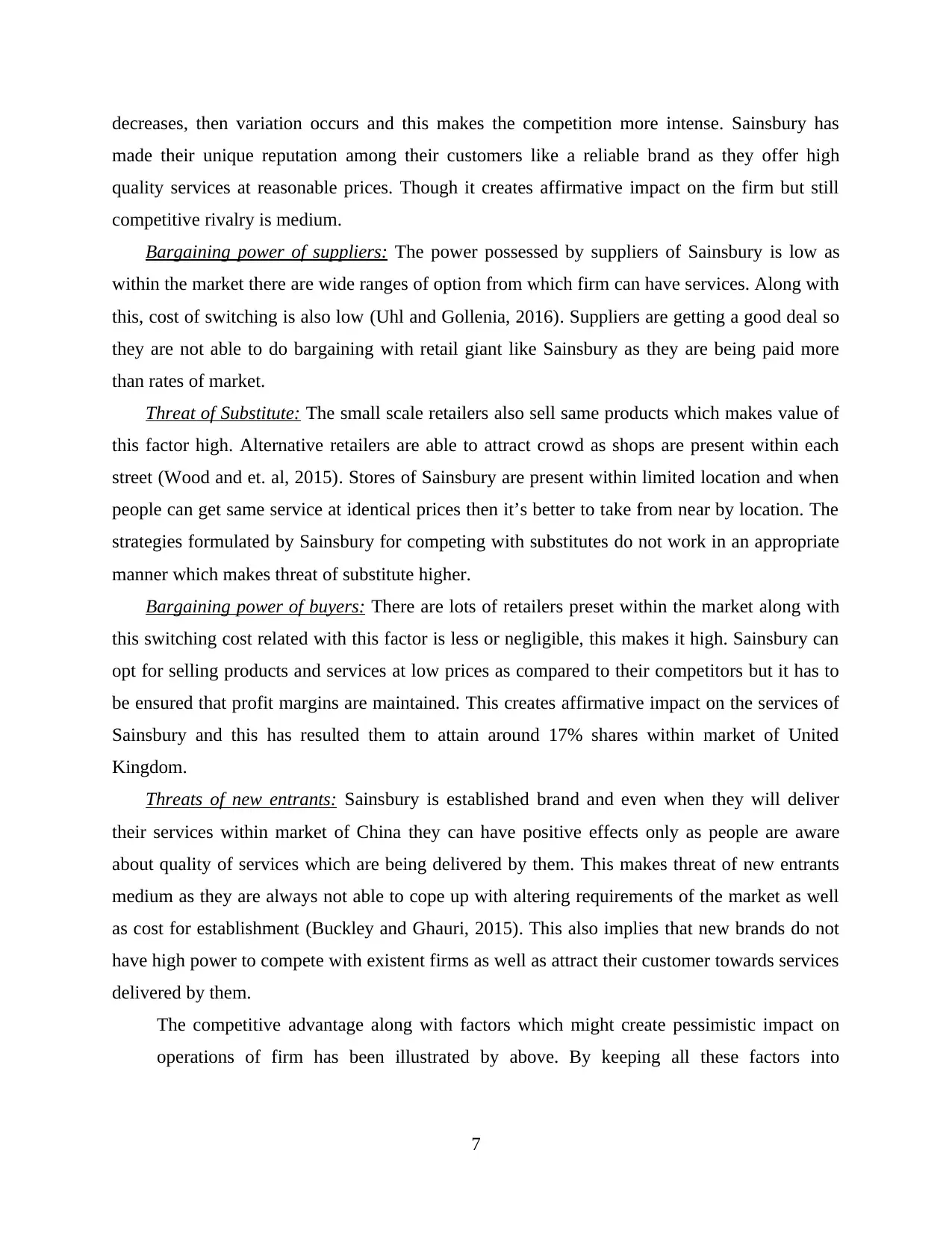
decreases, then variation occurs and this makes the competition more intense. Sainsbury has
made their unique reputation among their customers like a reliable brand as they offer high
quality services at reasonable prices. Though it creates affirmative impact on the firm but still
competitive rivalry is medium.
Bargaining power of suppliers: The power possessed by suppliers of Sainsbury is low as
within the market there are wide ranges of option from which firm can have services. Along with
this, cost of switching is also low (Uhl and Gollenia, 2016). Suppliers are getting a good deal so
they are not able to do bargaining with retail giant like Sainsbury as they are being paid more
than rates of market.
Threat of Substitute: The small scale retailers also sell same products which makes value of
this factor high. Alternative retailers are able to attract crowd as shops are present within each
street (Wood and et. al, 2015). Stores of Sainsbury are present within limited location and when
people can get same service at identical prices then it’s better to take from near by location. The
strategies formulated by Sainsbury for competing with substitutes do not work in an appropriate
manner which makes threat of substitute higher.
Bargaining power of buyers: There are lots of retailers preset within the market along with
this switching cost related with this factor is less or negligible, this makes it high. Sainsbury can
opt for selling products and services at low prices as compared to their competitors but it has to
be ensured that profit margins are maintained. This creates affirmative impact on the services of
Sainsbury and this has resulted them to attain around 17% shares within market of United
Kingdom.
Threats of new entrants: Sainsbury is established brand and even when they will deliver
their services within market of China they can have positive effects only as people are aware
about quality of services which are being delivered by them. This makes threat of new entrants
medium as they are always not able to cope up with altering requirements of the market as well
as cost for establishment (Buckley and Ghauri, 2015). This also implies that new brands do not
have high power to compete with existent firms as well as attract their customer towards services
delivered by them.
The competitive advantage along with factors which might create pessimistic impact on
operations of firm has been illustrated by above. By keeping all these factors into
7
made their unique reputation among their customers like a reliable brand as they offer high
quality services at reasonable prices. Though it creates affirmative impact on the firm but still
competitive rivalry is medium.
Bargaining power of suppliers: The power possessed by suppliers of Sainsbury is low as
within the market there are wide ranges of option from which firm can have services. Along with
this, cost of switching is also low (Uhl and Gollenia, 2016). Suppliers are getting a good deal so
they are not able to do bargaining with retail giant like Sainsbury as they are being paid more
than rates of market.
Threat of Substitute: The small scale retailers also sell same products which makes value of
this factor high. Alternative retailers are able to attract crowd as shops are present within each
street (Wood and et. al, 2015). Stores of Sainsbury are present within limited location and when
people can get same service at identical prices then it’s better to take from near by location. The
strategies formulated by Sainsbury for competing with substitutes do not work in an appropriate
manner which makes threat of substitute higher.
Bargaining power of buyers: There are lots of retailers preset within the market along with
this switching cost related with this factor is less or negligible, this makes it high. Sainsbury can
opt for selling products and services at low prices as compared to their competitors but it has to
be ensured that profit margins are maintained. This creates affirmative impact on the services of
Sainsbury and this has resulted them to attain around 17% shares within market of United
Kingdom.
Threats of new entrants: Sainsbury is established brand and even when they will deliver
their services within market of China they can have positive effects only as people are aware
about quality of services which are being delivered by them. This makes threat of new entrants
medium as they are always not able to cope up with altering requirements of the market as well
as cost for establishment (Buckley and Ghauri, 2015). This also implies that new brands do not
have high power to compete with existent firms as well as attract their customer towards services
delivered by them.
The competitive advantage along with factors which might create pessimistic impact on
operations of firm has been illustrated by above. By keeping all these factors into
7
Paraphrase This Document
Need a fresh take? Get an instant paraphrase of this document with our AI Paraphraser
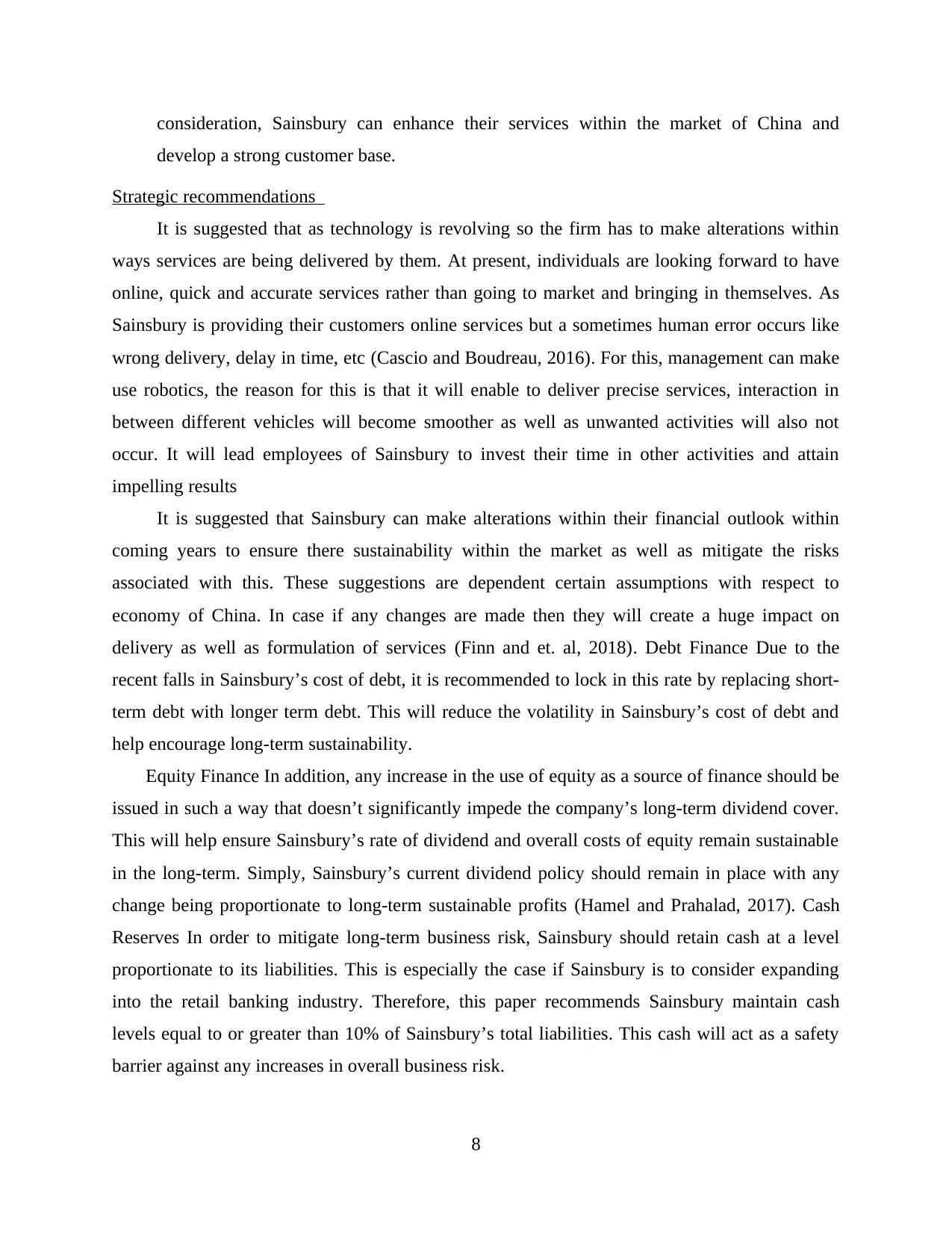
consideration, Sainsbury can enhance their services within the market of China and
develop a strong customer base.
Strategic recommendations
It is suggested that as technology is revolving so the firm has to make alterations within
ways services are being delivered by them. At present, individuals are looking forward to have
online, quick and accurate services rather than going to market and bringing in themselves. As
Sainsbury is providing their customers online services but a sometimes human error occurs like
wrong delivery, delay in time, etc (Cascio and Boudreau, 2016). For this, management can make
use robotics, the reason for this is that it will enable to deliver precise services, interaction in
between different vehicles will become smoother as well as unwanted activities will also not
occur. It will lead employees of Sainsbury to invest their time in other activities and attain
impelling results
It is suggested that Sainsbury can make alterations within their financial outlook within
coming years to ensure there sustainability within the market as well as mitigate the risks
associated with this. These suggestions are dependent certain assumptions with respect to
economy of China. In case if any changes are made then they will create a huge impact on
delivery as well as formulation of services (Finn and et. al, 2018). Debt Finance Due to the
recent falls in Sainsbury’s cost of debt, it is recommended to lock in this rate by replacing short-
term debt with longer term debt. This will reduce the volatility in Sainsbury’s cost of debt and
help encourage long-term sustainability.
Equity Finance In addition, any increase in the use of equity as a source of finance should be
issued in such a way that doesn’t significantly impede the company’s long-term dividend cover.
This will help ensure Sainsbury’s rate of dividend and overall costs of equity remain sustainable
in the long-term. Simply, Sainsbury’s current dividend policy should remain in place with any
change being proportionate to long-term sustainable profits (Hamel and Prahalad, 2017). Cash
Reserves In order to mitigate long-term business risk, Sainsbury should retain cash at a level
proportionate to its liabilities. This is especially the case if Sainsbury is to consider expanding
into the retail banking industry. Therefore, this paper recommends Sainsbury maintain cash
levels equal to or greater than 10% of Sainsbury’s total liabilities. This cash will act as a safety
barrier against any increases in overall business risk.
8
develop a strong customer base.
Strategic recommendations
It is suggested that as technology is revolving so the firm has to make alterations within
ways services are being delivered by them. At present, individuals are looking forward to have
online, quick and accurate services rather than going to market and bringing in themselves. As
Sainsbury is providing their customers online services but a sometimes human error occurs like
wrong delivery, delay in time, etc (Cascio and Boudreau, 2016). For this, management can make
use robotics, the reason for this is that it will enable to deliver precise services, interaction in
between different vehicles will become smoother as well as unwanted activities will also not
occur. It will lead employees of Sainsbury to invest their time in other activities and attain
impelling results
It is suggested that Sainsbury can make alterations within their financial outlook within
coming years to ensure there sustainability within the market as well as mitigate the risks
associated with this. These suggestions are dependent certain assumptions with respect to
economy of China. In case if any changes are made then they will create a huge impact on
delivery as well as formulation of services (Finn and et. al, 2018). Debt Finance Due to the
recent falls in Sainsbury’s cost of debt, it is recommended to lock in this rate by replacing short-
term debt with longer term debt. This will reduce the volatility in Sainsbury’s cost of debt and
help encourage long-term sustainability.
Equity Finance In addition, any increase in the use of equity as a source of finance should be
issued in such a way that doesn’t significantly impede the company’s long-term dividend cover.
This will help ensure Sainsbury’s rate of dividend and overall costs of equity remain sustainable
in the long-term. Simply, Sainsbury’s current dividend policy should remain in place with any
change being proportionate to long-term sustainable profits (Hamel and Prahalad, 2017). Cash
Reserves In order to mitigate long-term business risk, Sainsbury should retain cash at a level
proportionate to its liabilities. This is especially the case if Sainsbury is to consider expanding
into the retail banking industry. Therefore, this paper recommends Sainsbury maintain cash
levels equal to or greater than 10% of Sainsbury’s total liabilities. This cash will act as a safety
barrier against any increases in overall business risk.
8
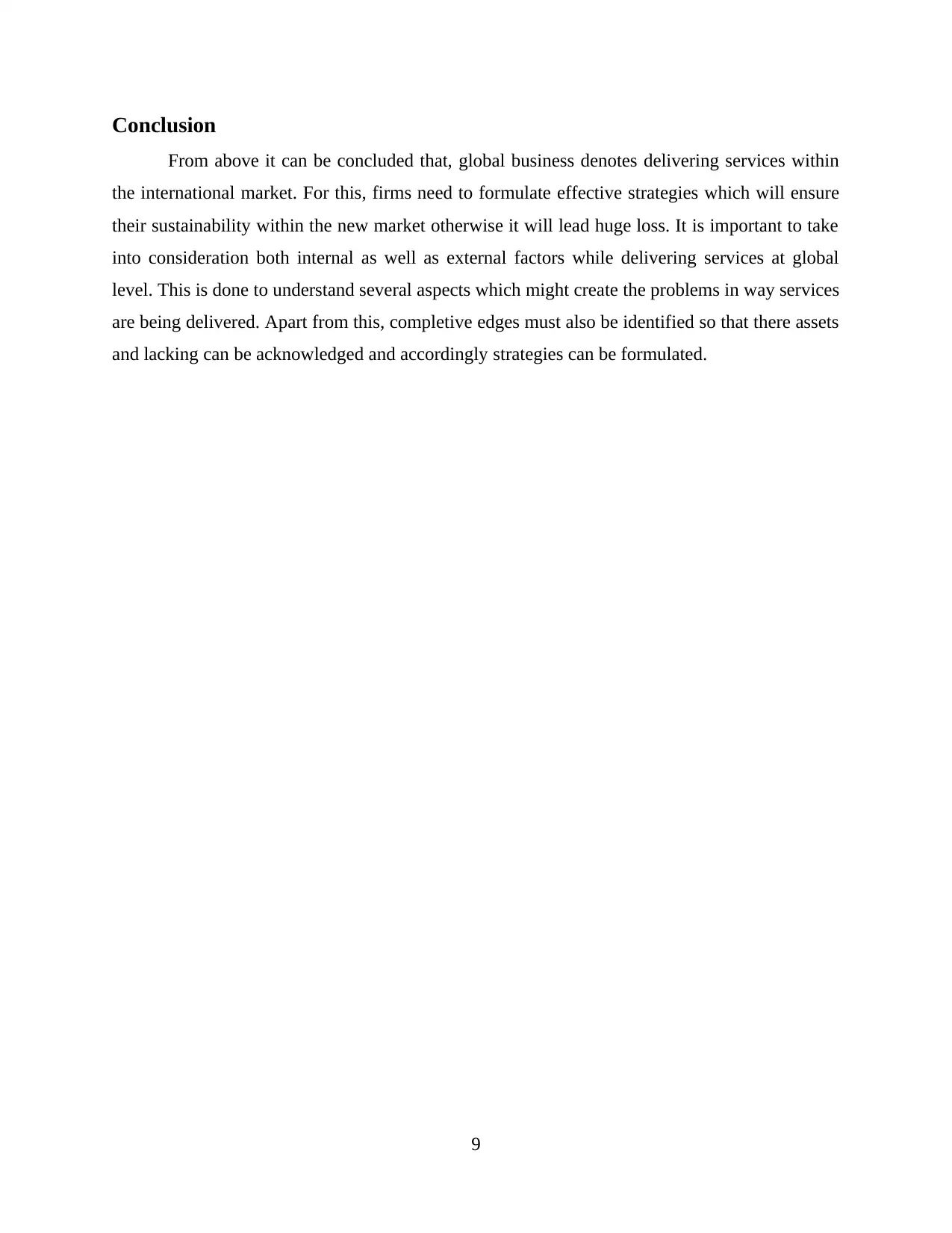
Conclusion
From above it can be concluded that, global business denotes delivering services within
the international market. For this, firms need to formulate effective strategies which will ensure
their sustainability within the new market otherwise it will lead huge loss. It is important to take
into consideration both internal as well as external factors while delivering services at global
level. This is done to understand several aspects which might create the problems in way services
are being delivered. Apart from this, completive edges must also be identified so that there assets
and lacking can be acknowledged and accordingly strategies can be formulated.
9
From above it can be concluded that, global business denotes delivering services within
the international market. For this, firms need to formulate effective strategies which will ensure
their sustainability within the new market otherwise it will lead huge loss. It is important to take
into consideration both internal as well as external factors while delivering services at global
level. This is done to understand several aspects which might create the problems in way services
are being delivered. Apart from this, completive edges must also be identified so that there assets
and lacking can be acknowledged and accordingly strategies can be formulated.
9
⊘ This is a preview!⊘
Do you want full access?
Subscribe today to unlock all pages.

Trusted by 1+ million students worldwide
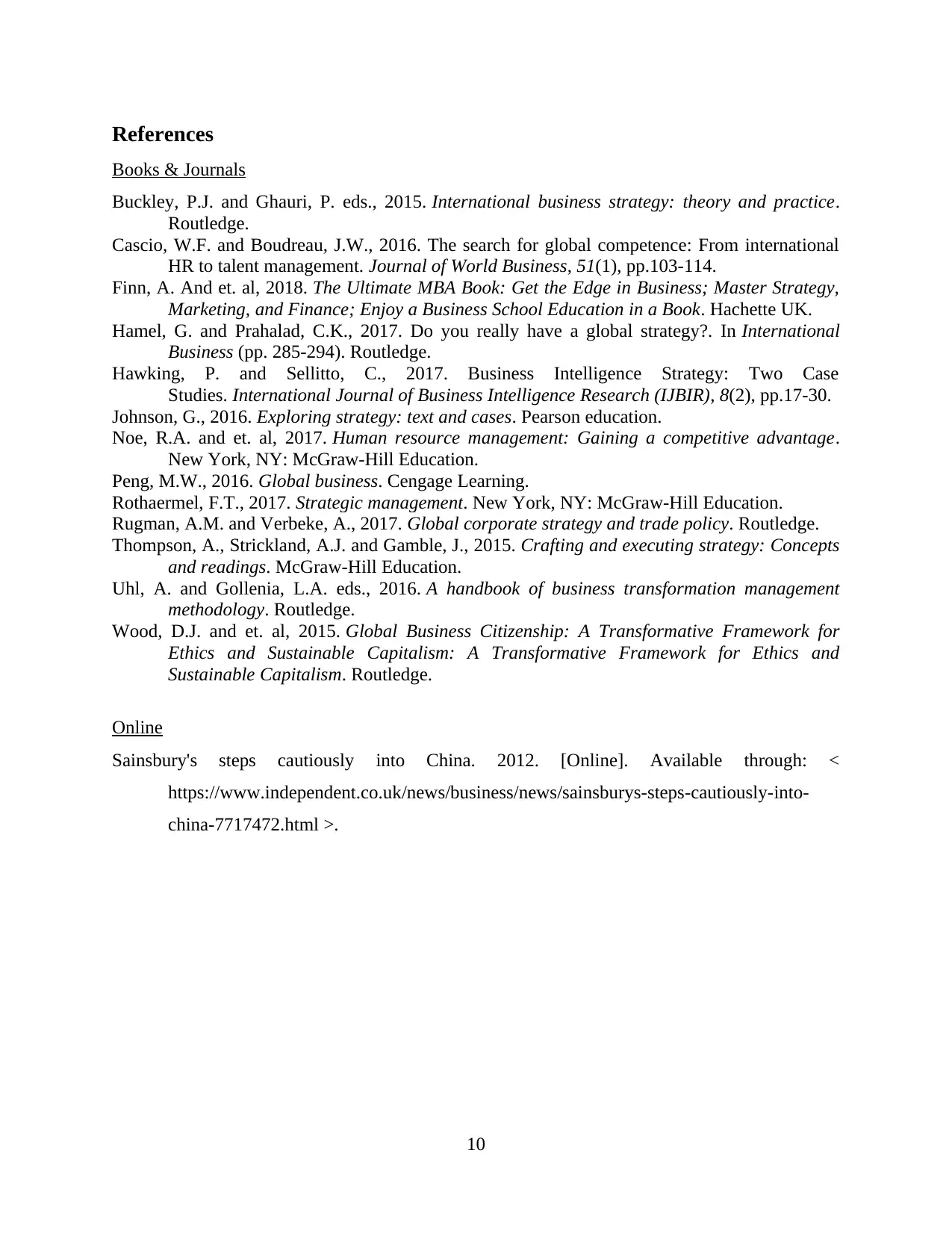
References
Books & Journals
Buckley, P.J. and Ghauri, P. eds., 2015. International business strategy: theory and practice.
Routledge.
Cascio, W.F. and Boudreau, J.W., 2016. The search for global competence: From international
HR to talent management. Journal of World Business, 51(1), pp.103-114.
Finn, A. And et. al, 2018. The Ultimate MBA Book: Get the Edge in Business; Master Strategy,
Marketing, and Finance; Enjoy a Business School Education in a Book. Hachette UK.
Hamel, G. and Prahalad, C.K., 2017. Do you really have a global strategy?. In International
Business (pp. 285-294). Routledge.
Hawking, P. and Sellitto, C., 2017. Business Intelligence Strategy: Two Case
Studies. International Journal of Business Intelligence Research (IJBIR), 8(2), pp.17-30.
Johnson, G., 2016. Exploring strategy: text and cases. Pearson education.
Noe, R.A. and et. al, 2017. Human resource management: Gaining a competitive advantage.
New York, NY: McGraw-Hill Education.
Peng, M.W., 2016. Global business. Cengage Learning.
Rothaermel, F.T., 2017. Strategic management. New York, NY: McGraw-Hill Education.
Rugman, A.M. and Verbeke, A., 2017. Global corporate strategy and trade policy. Routledge.
Thompson, A., Strickland, A.J. and Gamble, J., 2015. Crafting and executing strategy: Concepts
and readings. McGraw-Hill Education.
Uhl, A. and Gollenia, L.A. eds., 2016. A handbook of business transformation management
methodology. Routledge.
Wood, D.J. and et. al, 2015. Global Business Citizenship: A Transformative Framework for
Ethics and Sustainable Capitalism: A Transformative Framework for Ethics and
Sustainable Capitalism. Routledge.
Online
Sainsbury's steps cautiously into China. 2012. [Online]. Available through: <
https://www.independent.co.uk/news/business/news/sainsburys-steps-cautiously-into-
china-7717472.html >.
10
Books & Journals
Buckley, P.J. and Ghauri, P. eds., 2015. International business strategy: theory and practice.
Routledge.
Cascio, W.F. and Boudreau, J.W., 2016. The search for global competence: From international
HR to talent management. Journal of World Business, 51(1), pp.103-114.
Finn, A. And et. al, 2018. The Ultimate MBA Book: Get the Edge in Business; Master Strategy,
Marketing, and Finance; Enjoy a Business School Education in a Book. Hachette UK.
Hamel, G. and Prahalad, C.K., 2017. Do you really have a global strategy?. In International
Business (pp. 285-294). Routledge.
Hawking, P. and Sellitto, C., 2017. Business Intelligence Strategy: Two Case
Studies. International Journal of Business Intelligence Research (IJBIR), 8(2), pp.17-30.
Johnson, G., 2016. Exploring strategy: text and cases. Pearson education.
Noe, R.A. and et. al, 2017. Human resource management: Gaining a competitive advantage.
New York, NY: McGraw-Hill Education.
Peng, M.W., 2016. Global business. Cengage Learning.
Rothaermel, F.T., 2017. Strategic management. New York, NY: McGraw-Hill Education.
Rugman, A.M. and Verbeke, A., 2017. Global corporate strategy and trade policy. Routledge.
Thompson, A., Strickland, A.J. and Gamble, J., 2015. Crafting and executing strategy: Concepts
and readings. McGraw-Hill Education.
Uhl, A. and Gollenia, L.A. eds., 2016. A handbook of business transformation management
methodology. Routledge.
Wood, D.J. and et. al, 2015. Global Business Citizenship: A Transformative Framework for
Ethics and Sustainable Capitalism: A Transformative Framework for Ethics and
Sustainable Capitalism. Routledge.
Online
Sainsbury's steps cautiously into China. 2012. [Online]. Available through: <
https://www.independent.co.uk/news/business/news/sainsburys-steps-cautiously-into-
china-7717472.html >.
10
1 out of 10
Related Documents
Your All-in-One AI-Powered Toolkit for Academic Success.
+13062052269
info@desklib.com
Available 24*7 on WhatsApp / Email
![[object Object]](/_next/static/media/star-bottom.7253800d.svg)
Unlock your academic potential
Copyright © 2020–2025 A2Z Services. All Rights Reserved. Developed and managed by ZUCOL.





